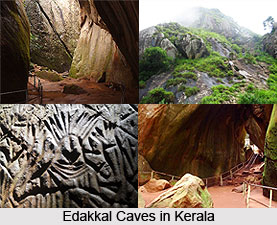 Edakkal caves are two natural caves located 25km away from Kalpetta and 1,200m above sea level on Ambukutty Mala in the Wayanad district of Kerala in Western Ghats. It is situated beside an ancient trade route that connects the mountains of Mysore to the ports of Malabar Coast. There are pictorial writings that date back to 5000 BC. The caves showcase nature"s skill and philosophy on architecture. This indicates the presence of a prehistoric civilization in this region. The Stone Age carvings of Edakkal are the only known examples from south India.
Edakkal caves are two natural caves located 25km away from Kalpetta and 1,200m above sea level on Ambukutty Mala in the Wayanad district of Kerala in Western Ghats. It is situated beside an ancient trade route that connects the mountains of Mysore to the ports of Malabar Coast. There are pictorial writings that date back to 5000 BC. The caves showcase nature"s skill and philosophy on architecture. This indicates the presence of a prehistoric civilization in this region. The Stone Age carvings of Edakkal are the only known examples from south India.
Structure
The name "Edakkal" literally means "a stone in between". As the name indicates, it seems that one boulder miraculously wedged in between two bigger ones to create a cave. Technically they cannot be termed as caves. It is rather a rift comprising of two chambers. The lower chamber is 18 ft long, 12 ft wide and 10 ft high and the upper chamber is 96 ft long, 22 ft wide and 18 ft high. There is a large rock which has fallen forming a roof over it causing a split from the main body and this large cleft and the roof-rock gives it the appearance of a cave. The carvings comprises of human and animal figures, tools used by humans that indicates the presence of a prehistoric settlement.
Legends and Beliefs
Many legends are associated with the gigantic fissure at Edakkal. People believe that Lord Rama, one of the earlier visitors of this area, shot an arrow which pierced the mountain and created a deep cleft there. The name of the hills, Ambukutty too is derived from this legend. Another one is associated with Kutti Chathan and the Goddess Mudiampilly. The local people used to have a pilgrimage trip to this place to honour the Goddess.
Discovery of the Edakkal Cave
The caves were accidentally discovered by Fred Fawcett, the then Superintendent of Police of the Malabar district in 1890, during his hunting trip to Wayanad. He discovered the Edakkal rock-shelter, situated on the western side of Edakkalmala. To his surprise, he identified the place as a habitat of Neolithic people. He immediately wrote an article thereby attracting the attention of many scholars. Edakkal caves have drawn great attention of archeologists and historians worldwide.
Petroglyphs inside the Edakkal Cave
There are three types of petroglyphs inside the cave. The oldest may date back to around more than 8,000 years. There have been evidences that the caves were inhabited several times at different points. One can find drawings that range over periods from as early as 5000 BC to 1000 BC.
Edakkal caves are famous for its cave paintings, which are considered to be of 6000 B C. The rock surface is full of linear motifs and one can see weird shaped figures, crosses, triangles, tridents, squares, stars, wheels, spirals, plant motifs, pot shaped items, various animals and human figures. Images of a tribal king, a queen, a child, a deer and an elephant can be seen on the wall. A human figure with headgear, another on a wheeled cart and some male and female figures too can be seen. There are images of tools used by earlier human beings and many other symbols, on the walls of the caves which suggest the presence of pre historic men. These carvings give great evidence for a highly civilized society who lived in the pre-historic age.
Edakkal is the only known place in India with Stone Age carvings. There are carvings belonging to Neolithic and Mesolithic age. The human figures of these caves have raised hair and some have masks. They all have archeological significance and are interesting too. Along with these pictorial carvings, there are also Tamil and Brahmi Script in Edakkal caves.
Edakkal is said to have some links with Indus Valley Civilization too. Around 400 signs were discovered recently, which had shown its relationship with the ancient civilization. The prominent among them was "a man with a jar cup".
Route to Edakkal Caves
To reach the caves, one has to trek through the Ambukutty Mala. It will take around 45 minutes to climb the hill. The visiting time to Edakkal caves is from morning 9:30 to evening 4:30. One can reach the lower part of the Ambukutty hills via bus or car and from there one has to climb the hills. Till mid way of the hills, one can make use of the jeeps arranged by the DTPC. To enter the caves, a reasonable entry fee is required to pay.



















